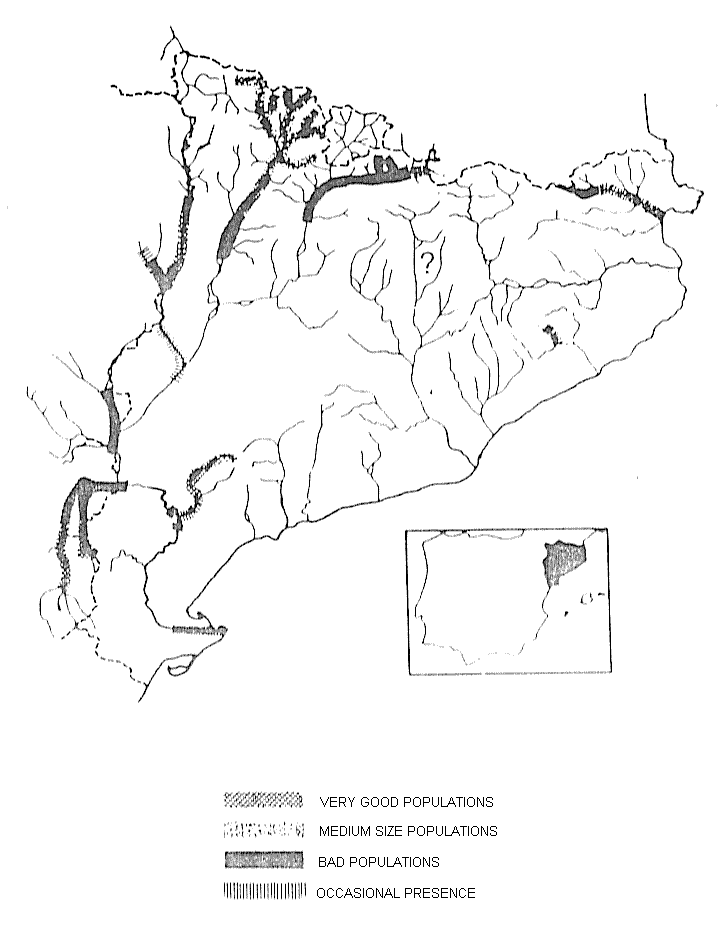 |
Last Update:
Friday November 23, 2018
|
| [Home] |
|
Volume 4 Pages 1 - 45 (March 1989) Citation: Ruiz-Olmo, J. (1989) Creation of Natural Reserves to Protect the Otter (Lutra lutra) in Catalonia (N.E. Iberia) IUCN Otter Spec. Group Bull. 4: 31 - 35 Creation of Natural Reserves to Protect the Otter (Lutra lutra) in Catalonia (N.E. Iberia) Jordi Ruiz-Olmo Servei de Protecció de la Natura, Direcció General de Politica Forestal, C / Còrsega, 329, 5, 08037 - Barcelona, Spain INTRODUCTION The otter survey of Spain was carried out between July 1984 and January 1985 (Delibes, 1984). In Catalonia, virtually the whole region was surveyed for spraints and footprints. Additional field work was carried out and verified oral information on the presence of otters was collected. The results are shown in Figure l. Some of the ecological requirements of the species, its food habits and problems specific to the area were also studied (Ruiz-Olmo, 1985).
LEGAL ASPECTS The 12/1985 law for natural areas decreed by the autonomous government of the Generalitat of Catalonia provides the framework for nature conservation in the whole of Catalonia. Natural reserves have been created and can be of two types: Integral (RNI) and Partial (RNP). In the former, all use or exploitation of the reserve, which could damage or alter its special characteristics. The RNPs have begun to play an important role in relation to otter conservation in Catalonia especially since, in Spain, all rivers and natural waters are public property. RNP DECLARATION . Of the 15 RNPs designated by the Decret 123/1987 for the protection and preservation of fauna, 11 are for otter protection (Figure 2). By comparing Figures l and 2, it can be seen that nearly all the populations of L. lutra in Catalonia are afforded some protection by RNPs within their ranges. There are however two exceptions : The Montsant river, where proposals to build a dam have prevented the declaration of a RNP and the Riera de Merlès which, while having no evidence of otter presence, has interesting natural characteristics and here the polecat (Mustela putorius) occurs. This species is endangered in Catalonia.
In total, 163km of river are protected within the RNPs. Protected lengths vary between 2 and 45 km. (see Table 1). The characteristics of the RHPs are diverse and varied and they all contribute to the conservation of certain ecosystems and species typical of N.E. Iberia. In these RNPs the following activities are regulated : it is prohibited to destroy or modify the bankside vegetation, to cause pollution or to affect in any way, the river bed. Exploitation of the water is regulated so as not to affect the otter.
PROVISIONAL CONCLUSIONS The declaration of the RNPs has proved a useful tool in the conservation of otters in Catalonia. Certain road projects (in canyons), which could have had irreversible effects, have been stopped. The use of the rivers for hydro-electric power and for irrigation, which both have a very negative effect on rivers in N.E. Iberia, is regulated or prohibited . Bankside vegetation is respected. A new RNP in an area holding otters (Cellers on Figure 2) is sure to be created and other sites are being studied. However, there is still a lot to do, and these RNPs are not enough. This is why we are now carrying out a series of studies on the ecology of the otter. REFERENCES Delibes, M. (1984) La Situación de l nutria
Lutra lutra L. en España (Julio-noviembre, 1984). Unpublished report
to I.C.O.N.A., 60pp |
||||||||||||||||||||||||||||||||||||||||||||||||||||||||||||||||||||||||||||||||||||||||||||||||||||||||||||||||||||||||||||||||||||||||||||
| [Copyright © 2006 - 2050 IUCN/SSC OSG] | [Home] | [Contact Us] |

